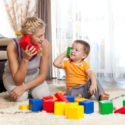Parents often ask me about good toys to promote communication. Here are a few suggestions for toys and activities to help your child’s language development. The best part is, they’ll be having so much fun that they won’t even realise they’re learning.
- First of all, messy play. I’m putting messy play at the top because children love it. It’s a good way of stimulating their senses and imagination, as well as developing motor skills and, of course, language. Painting, modelling with salt dough, building with cardboard and pasting and sticking are all good activities to try.
- Sand and water play. Once again, these are great ways to activate the senses, practice cause and effect (‘I can bash the sandcastle with my foot and squash it flat!’), promote motor skills and learn language. Ape David Attenborough by adding your own commentary. You can comment on what’s happening as it’s happening. Try saying things like “ooh, I like your castle” and “the stick is on the top”. Using commentary like this allows your child to hear lots of language. This is useful for building up their store of vocabulary and grammar.
- Listening games. Listening is a key skill for learning language. The Department for Education and Skills has produced a brilliant publication called ‘Letters and Sounds’. It’s easy to follow and has lots of good suggestions for listening games. https://www.gov.uk/government/uploads/system/uploads/attachment_data/file/190599/Letters_and_Sounds_-_DFES-00281-2007.pdf
- Ready, steady, go! games. You can help lengthen your child’s attention span by using “Ready, steady, go!” style games. These can revolve around anything your child enjoys, for example throwing a ball for them to catch, letting a car go down a ramp, firing a toy rocket, letting a ball go down a ball run or starting a running race.
- Imaginative play. This is a great building block for learning language. Research shows that the development of imaginative play and language are closely linked. If your child is interested in large dolls, like babies and teddies, you can play giving them a bath, putting them to bed, washing their faces, brushing their teeth and having a tea party. If your child is interested in smaller toys of people and animals, you can, for example, make them drive a toy car, get on the bus or go to the park.
6. Playdough. This is another good activity which works on lots of different skills: it stimulates the senses, develops fine motor skills and is great for firing creativity and building language. Once again, you can use your commentary skills to add language. For example, you could say “ooh, you’ve got the red dough”, “squash it flat!”, “it looks like a snake”, “roll it out”. Comments like these, made at the relevant moment, help children to learn new words and grammar.
7.Duplo and lego. Whilst children are building, they are also using their imaginations and learning about colours and size. You can promote language learning by using commenting, as before. Children need to hear words lots of times before they start to use them in their own talking. And whilst learning words for objects, like “car”, “cup” and “shoe”, is relatively easy, concepts like size and colour are harder to grasp. So that’s where your play commentary comes in handy. Children can learn to build cooperatively too. Cooperative Lego building requires problem solving and talking to one another, which is great for developing communication skills.
8.Turn-taking games. Taking turns is an important foundation for conversational skills. Just like a conversation, first it’s my turn, then it’s your turn and so on. Your turn-taking game could be as simple as rolling a ball to and fro between you. You can take turns adding bricks to build a tower or pushing in swords during a game of ‘Pop up Pirate’. You can build turn-taking into lots of activities. Children may be keen to take all the turns themselves! But remember that turn-taking is a useful skill to learn and will support their communication development. So you may need to reinforce turn-taking, by saying “my turn”, “your turn” and making sure that the child does actually take turns. Then, of course, give them lots of praise when they do.


9.Sharing story books is good for language development. Picture books, lift-the-flap style books and ones with rhyming and alliteration are all good. Ask easy questions that you know your child can answer, for example “where’s the bear?” Children love to join in and get it right. With well-known books, ‘sentence completion’ is another useful tool. For example, you could say “But it wasn’t a shark. It was a…”. Then wait for your child to finish the sentence. This allows your child to be actively involved in the story telling.
If you have questions about your child’s speech and language development, get in touch.
Kirsty Henderson is a qualified Speech and Language Therapist, practising in Bristol.







Sorry, comments are closed for this post.